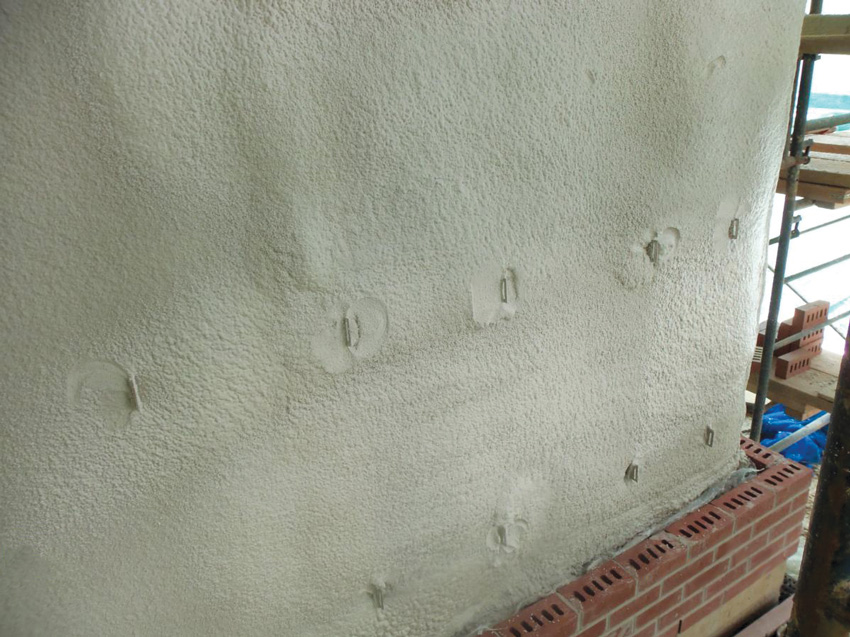Moisture Control with Spray Foam Insulation
Learning Objectives:
- Investigate the use of spray foam insulation to achieve multiple performance traits in one product, including thermal, air, and water resistance, while safeguarding indoor environmental quality, building safety, and health.
- Identify the characteristics of high-performance continuously insulated exterior wall assemblies related to green and sustainable design and construction.
- Explore how the performance characteristics of spray foam insulation can improve sustainability by controlling and preventing moisture issues from occurring in exterior walls.
- Assess the ability of spray foam insulation to be installed with fewer steps and at a lesser cost than assemblies using rigid foam board insulation.
Credits:
The design of building enclosures entails some very particular requirements that mandate attention to detail. Specifically, barriers of multiple types are needed to restrict air, water, vapor, and thermal transfer. This usually means that a wall assembly requires multiple products to address each one. An emerging alternative is to use a single product with multiple properties, thus eliminating construction steps and reducing labor and material costs accordingly. To work fully, that means the product or material has to demonstrate proven abilities to resist heat, water, and air movement through it in addition to providing a truly continuous installation in order to assure uninterrupted performance. Such a product exists in spray foam insulation systems that have been tested and proven to provide the multiple levels of protection needed in a single-product application. At the same time, it can allow more design freedom due to the custom, field-applied nature of the system. Hence, it is becoming a popular alternative among architects compared to a reliance on multiple, separate barrier products for air, water, vapor, and thermal transfer.

All images courtesy of Icynene, except as noted
Buildings of all shapes and sizes require exterior enclosures that provide air, water, moisture, and thermal barriers. Spray foam insulation can be used to provide all of these in addition to great thermal insulation properties.
Overview of Spray Foam Insulation
Spray foam insulation products have been successfully used in buildings for decades. Part of their appeal is that in addition to providing excellent thermal insulation capabilities, they can also provide a protective barrier that significantly reduces air leakage, minimizes airborne moisture transfer, and reduces bulk water transport. Since it is sprayed in place, almost monolithically, there are no seams or joints, thus creating a truly continuous layer in roof, floor, and wall assemblies. This continuity can be maintained particularly well in exterior wall continuous insulation designs, where the spray foam can be applied to the outside face of exterior sheathing, not just between the studs. These performance characteristics can not only satisfy building code requirements for weather-resistant barriers, they can also optimize energy efficiency by fully restricting heat flow and air leakage. From a design standpoint, spray foam insulation allows for plenty of architectural options. Unlike rigid board insulation products, it can be sprayed in place to conform completely against virtually any building geometry or shape, including curved and rounded forms.
Common Types of Spray Foam
Typically, spray foam insulation is polyurethane based and referred to as spray polyurethane foam (SPF). As a manufactured product, it can be formulated in different types and in different densities, producing correspondingly different characteristics. For buildings, it is usually classified as one of the following:
- Low-density foam weighs around 0.5 pounds per cubic foot (0.4–0.75 available) when installed. It is typically an open-cell product, which remains somewhat flexible in place and achieves R-values comparable to fibrous insulation on the order of R-3.7 per inch or so. Low-density spray foam is fairly vapor permeable and typically does not qualify as a water barrier. Further, low-density foam can only be used in interior applications, such as filling stud or joist cavities, not for exterior continuous insulation.
- Medium-density foam, as the name implies, is heavier and more rigid than low-density spray foam, coming in at about 2 pounds per cubic foot, or roughly four times heavier than low-density material. Its other defining characteristic is the closed-cell nature of the insulation when mixed. Since it becomes a series of small bubbles (cells) of trapped insulating gas (a blowing agent), the thermal performance is directly enhanced, resulting in a noticeable increase in R-value up to R-7.1 per inch. The makeup of medium-density spray foam also allows it to serve as a full air barrier, according to the Air Barrier Association of America (ABAA). Further, in terms of water vapor permeance, it tests and qualifies as a weather- and water-resistant barrier since very little water vapor passes through it.
Based on the differences between these two types of spray foam, it is clear that medium-density spray foam insulations offer the superior water- and moisture-barrier characteristics, the ability to be used as exterior continuous insulation, and much better thermal performance per inch of thickness. Collectively, this means that medium-density, closed-cell spray foam insulation provides the performance of four products in one: insulation, air barrier, vapor retarder, and water-resistive barrier. This combination of traits means it has the potential to save time and money during construction by eliminating the number of products installed or avoiding the need to cut and fit board-type insulation. Once the building is occupied, it also significantly reduces air leakage, minimizes water and moisture transfer, and optimizes energy efficiency.

Medium-density, closed-cell spray foam insulation can be applied very precisely in a controlled manner to create a very predictable surface behind cladding.
Spray Foam in Exterior Walls
All of these attributes make medium-density, closed-cell insulation suitable for many portions of the building enclosure. However, it is in exterior wall assemblies that it has become particularly popular. When used as continuous insulation over wall sheathing, it not only provides a superior insulation installation, it helps enhance the rest of the wall assembly as well. First, it should be noted that expanding spray foams or low-density foams create the irregular and bulbous forms that many people associate with spray foam insulation. However, medium-density foam is different in that it can be installed fairly precisely and in very controllable thicknesses. That means it creates a smooth and predictable surface that is ready to receive cladding over it.
Installing spray foam insulation is much simpler than installing rigid foam boards, which require fasteners, cutting, and waste. Spray foam has its own adhesive properties that keep it securely attached in place once applied and avoid waste. Of course, not all buildings are designed to be rectilinear, and even those that are often have some unique or irregular conditions along the walls. Rigid insulation boards are necessarily rectilinear and don’t bend or adapt easily to irregular conditions in a wall assembly. Therefore, they may not be a practical or realistic choice for certain buildings. By contrast, spray foam insulation conforms directly to the surface it is being applied to regardless of shape, geometry, or irregularities. That means that it fully covers and seals over the underlying construction to provide a truly continuous, uninterrupted insulation layer and protective barrier. It also means that buildings designed with intentional curves, domes, arches, angles, or other non-rectilinear shapes no longer need to suffer from lower performance because of limitations from other insulation types. For example, a curved surface would be very difficult if not impossible to cover properly with rigid foam board insulation. Mineral fiber batts or blankets do curve and may be used in wall cavities, including curved surfaces. However, they do not provide the same performance in terms of insulation level per inch, water resistance, or air resistance. Spray foam insulation provides excellent performance in all of those areas since its characteristics are not limited or influenced by the shape of the building.









